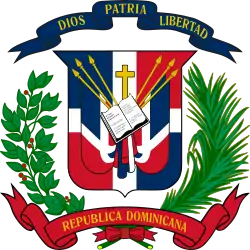Dominican Republic cuisine
| This article is part of a series on the |
| Culture of the Dominican Republic |
|---|
| Society |
| Symbols |
| Politics |
| Economy |
|
Dominican Republic portal |
Dominican cuisine is made up of Spanish, indigenous Taíno, Middle-Eastern and African influences. Many Middle-Eastern dishes have been adopted into Dominican cuisine, such as the "Quipe" that comes from the Lebanese kibbeh. Dominican cuisine is adopted from Puerto Rico and Cuba, though the dish names differ sometimes.
As in Spain, the largest, most important meal of the day is lunch. Its most typical form, nicknamed La Bandera ("The Flag"), consists of rice, red beans and meat (beef, chicken, pork, or fish), sometimes accompanied by a side of salad.
Dishes and their origins
The Dominican Republic was formerly a Spanish colony. Many Spanish traits are still present in the island. Many traditional Spanish dishes have found a new home in the Dominican Republic, some with a twist. African and Taíno dishes still hold strong, some of them unchanged.
All or nearly all food groups are accommodated in typical Dominican cuisine, as it incorporates meat or seafood; grains, especially rice, corn (native to the island[1]), and wheat; vegetables, such as beans and other legumes, potatoes, yuca, or plantains, and salad; dairy products, especially milk and cheese; and fruits, such as oranges, bananas, and mangos. However, there is heaviest consumption of starches and meats, and least of dairy products and non-starchy vegetables.
Sofrito, a sautéed mix including local herbs and spices, is used in many dishes. Throughout the south-central coast bulgur, or whole wheat, is a main ingredient in quipes and tipili, two dishes brought by Levantine Middle Eastern immigrants. Other favorite foods and dishes include chicharrón, yautía, pastelitos or empanadas, batata (sweet potato), pasteles en hoja (ground roots pockets), chimichurris, plátanos maduros (ripe plantain), yuca con mojo (boiled yuca/cassava) and tostones/fritos (fried plantains).
Bouillon cubes are used heavily in the preparation of Dominican lunch food.
Taíno dishes
Spanish dishes
- Arroz con leche o Arroz con dulce –rice pudding
- Crème caramel – sweet egg custard known as flan. Coconut flan is known as quesillo de coco.
African dishes
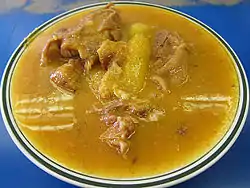
- Mangú – mashed, boiled plantains can be traced back to west Africa where it is known as fufu. This is a typical and official national breakfast in the Dominican Republic but can also be served at lunch and dinner. Mangú is typically served with queso frito (white cheese fried in a pan), fried Dominican salami, fried eggs and topped with onions cooked in vinegar. This is also known as los tres golpes (the three hits). Plantains can be replaced with green bananas or squash where it is known as mazamorra.
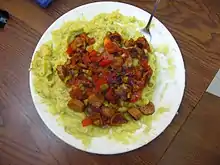 Mangú
Mangú
Middle Eastern dishes
- Arroz con almendras y pasas – A rice with raisins and almonds brought over by Lebanese. It is usually eaten around Christmas.
- Arroz con fideos - Rice cooked with toasted pasta. This dish is eaten with fresh cilantro.
- Kipes or Quipes - Deep fried bulgur roll filled with picadillo.
- Niño envuelto – Cabbage roll filled with rice. A dish brought over by Lebanese immigrants.
Other dishes
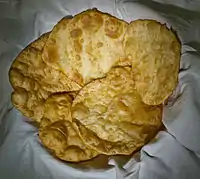
- Asopao - Rice, chicken or fish and vegetable soup similar to Gumbo originating in Puerto Rico. Dominicans have a unique asopao adding chicarron de pollo or coconut milk with seafood.
- Chen-chen – A cracked corn pilaf dish from Haiti thats made its way threw the Dominican Republic.
- Souflé de Batata con marshmallow – Sweet potato casserole is an American dish. Sweet potatoes are roasted with orange juice, sugar, spices and top with marshmallows. In the Dominican Republic sweet potatoes are replaced with batata. This is another Christmas classic.
- Moro de guandules – The Dominican Republic has adopted arroz con gandules (yellow-rice with pigeon peas, pork, olives and capers) known to Dominicans as moro de guandules.
- Yaniqueque – Jonnycakes, a dish brought by sugarcane workers from the Lesser Antilles over a century ago.
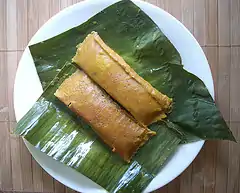
- Pasteles en hojas – A tamale made from plantains, squash and tubers. This is a Christmas tradition.
- Mofongo – Original from Puerto Rico. It is made from fried green plantains or fried yuca, seasoned with garlic, olive oil, and pork cracklings, then mashed with a little broth. Mofongo is usually served with a chicken broth soup.
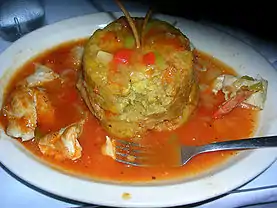 Mofongo
Mofongo - Tostones – known as fritos verdes. They are fried green plantain slices served flattened and salted.
 Tostones
Tostones - Pastelitos – They are similar to a hand pie, usually fried and stuffed with beef or cheese.
- Yuca con mojo - Boiled or fried cassava with olive oil, garlic, citrus, onions and cilantro. A classic Cuban dish popular among Dominicans and other Latin countries.
Dominican dishes
- Aguají – Vegan soup made with mashed plantains, allspice and sofrito.
- Arepitas – Shredded yuca or cornmeal fritters mixed with eggs, sugar, and anise seeds.
- Buche e perico – Literally parrot's cheek. A hearty corn stew made with mirepoix, garlic, tomatoes, cilantro, smoked pork chops and squash.
- Camarones con coco y gengibre – Shrimp with coconut and ginger. This dish is prepared with Dominican seasoning as a base and with the addition of coconut milk and ginger.
- Chicharrón de pollo – fried chicken.
- Chimichurris – Hamburger topped with fry sauce (mayo and ketchup), tomatoes, and cabbage in a hero bread.
- Chulitos - Fresh grated cassava filled with ground meat.
- Rice dishes – Most dishes in the Dominican Republic are served with rice. A popular staple of the Dominican cuisine is arroz con maiz that combines the sweet flavor of corn with the salty flavor of rice and other ingredients.
Locrio a classic style of mixing rice with other kind of meat; this dish is usually served with a salad, yuca or plantains. Moro de guandules con coco a rice, pigeon peas (guandules), and coconut milk dish. Concón is usually something not cooked on its own. Instead, it is a byproduct of cooking rice. Simply put, it is the layer of burnt hard rice left behind when cooking in a caldero (iron pot). It contains the most flavor.
- Soups – Dominicans take much pride in their soups and most cooks on the island claim to make the best soup. More than a third of the country’s total population lives in poverty, and almost 20 per cent are living in extreme poverty. In rural areas poor people constitute half of the population. Soup in the Dominican Republic are easy, cheap and can feed a large number of people. Chambre a legumes, rice and meat stew. Chapea a red or white beans stew with mashed squash, longaniza (sausage), and ripe plantains. Dominican Republic has also adopted many soups like sancocho the Dominican national soup, mondongo (beef tripe soup), crema de cepa de apio (celery root soup).
- Spaghetti a la Dominicana – Spaghetti cooked with Dominican salami, celery, stewed tomatoes, onions, garlic, tomato sauce, orégano, and olives and then afterwards meat sauce is poured. Also served for breakfast, lunch and dinner. Recipe tends to vary.
- Telera – Dominican bread similar to Mexican Telera.
- Pan de coco – Coconut bread.
- Pico y pala – Pick and shovel. Chicken feet and neck is associated with the popular dining rooms and cafeterias, very common in low income neighborhoods. Usually cooked with onions, cilantro, culantro, oregano, and sugar.
- Guisados – Braised meat or fish cooked a have tomato sauce base with Dominican style sofrito. A small amount of sour orange or lime juice, and sugar is traditional added. When done it is served with rice. This is a popular staple in Dominican kitchens. Carne mechada is braised tenderloin or flank. Brasied oxtail and cow tongue are usually spicy using scotch bonnet or other local chilies. Beans and vegetables are cooked the same but with no citrus added.
- Pastelón – Casseroles. A main element of Dominican cuisine. There are more than six variations in the Dominican Republic the most popular ones being pastelón de platano maduro (yellow plantain casserole) and pastelón de yuca (cassava casserole). Pastelón can be found in other Latin American Countries like Puerto Rico, Venezuela, Panama and Cuba, specially the eastern part which has great Dominican influence. Pastelón are usually stuffed with ground meat or chicken.
- Wasakaka – A sauce served on roasted or grilled chicken made from lime juice, parsley, garlic, olive oil, salt and pepper.
Desserts
- Almibar de frutas – Fruit cooked in syrup. The most popular is called mala rabia. Guava, sweet plantains, and sweet potato with cinnamon.
- Arepa – Cornmeal and coconut cake. Dominican arepa is different from that of the Venezuelan and Colombian arepa.
- Bizcocho Dominicano – Dominican cake uses a basic cake recipe with vanilla, eggs, flour, sugar, margarine, and baking soda, milk with orange juice and lime zest. When done the cake is then filled with pineapple jam and frosted with meringue.
- Canquiña
- Chaca – Corn pudding made with cracked corn, milk, cinnamon, clove and sometimes cooked rice.
- Dulce de coco tierno – Fresh coconut cooked slowly with milk, sugar and cinnamon.
- Dulce de Leche en Tabla – Milk fudge usually eaten with pineapple jam.
- Gofio – A sweet cornmeal powder from the Canary islands.
- Habichuelas con dulce – Sweet creamed beans dessert. Made with coconut milk, sweet potato chunks, etc.
- Jalao – Round-looking balls that are made with just shredded coconut and honey.
- Jalea de batata – Sweet potato pudding.
- Majarete – Corn pudding made with fresh corn, cornstarch, milk, vanilla and cinnamon. Some Dominicans add coconut milk and nutmeg.
- Macaroon – Coconut macaroons are popular all over the island. Most popular flavors are with added ginger with cinnamon and condensed milk macaroons.
- Palitos de coco – Shredded coconut lollipops cooked with condensed milk. When done they are formed into small balls and coated in a simple syrup made from sugar, corn syrup, and red food coloring.
Beverages
The most popular drinks in the Dominican Republic are rum locally known as romo, beer (especially Presidente), eggnog with rum, local fruit smoothies, peanut punch called chocolate de maní brought over from Jamaica, mabí juice made from colubrina bark or fruit that's done all over the Caribbean. Alcohol drinks such as piña colada, coquito, Cuba libre, and mojitos from Cuba and Puerto Rico.
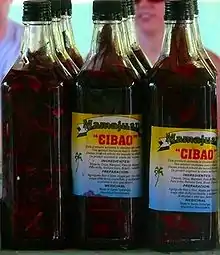
- Mama Juana – an alcoholic drink concocted by allowing rum, red wine, and honey to soak in a bottle with tree bark and herbs.
- Pera Piña - Rice and pineapple peel drink.
- Jugo de avena – oatmeal juice made with oats, orange peel, ginger, sugar, milk, and spices.
- Morir Soñando - Evaporated milk, sugar, and orange juice.
- Coffee (usually done with a moka pot).
Geographical differences
What Dominicans tend to eat depends highly on where they live: whether near the sea or in the interior mountains. In either case, most Dominican meat dishes tend to involve pork, as pigs are farmed quite heavily on the island. Meat dishes tend to be very well cooked or even stewed in Dominican restaurants, a tradition stemming from the lesser availability of refrigeration on the island.
Seaside Dominican fishing villages will have great varieties of seafood, the most common being shrimp, marlin, mahi-mahi or dorado, and lobster. Most villagers more commonly dine on cheap, lesser-quality fish, usually stewed with la criolla, a type of rice. Premium seafood tends to be too expensive for the many locals, and is saved for the island's upper class and the tourist resorts.
Differences between Dominican cuisine and those of other parts of the West Indies include the milder spicing, which mainly uses onions, garlic, cilantro, cilantro ancho (culantro), ají cubanela (cubanelle pepper), and oregano. Dominican sofrito is known on the island as sazón.
References
- "Food Crops". U.S. Library of Congress. Retrieved 2011-02-10.
Further reading
- Castro, Marianela; Clavé, Montse; Alcántara, Luz María (1996). Cocina Dominicana: Volume 2 of Cocinas de allí, aquí. Icaria Editorial. ISBN 978-84-7426-277-3.
- Féliz-Camilo, Arturo (2012). Las recetas de Mamá Pura: Volume 1 El Fogoncito collection (Arturo Féliz-Camilo). CreateSpace. ISBN 978-1-4752-8083-8.
- Féliz-Camilo, Arturo (2013). Diccionario Culinario Dominicano (Arturo Féliz-Camilo). CreateSpace. ISBN 978-1-4840-1111-9.
- Féliz-Camilo, Arturo (2013). Diccionario Culinario Dominicano (Arturo Féliz-Camilo). CreateSpace. ISBN 978-1-4840-1111-9.
